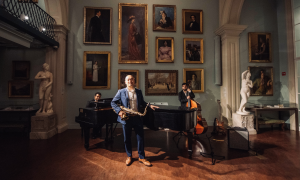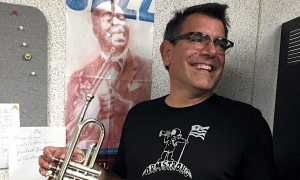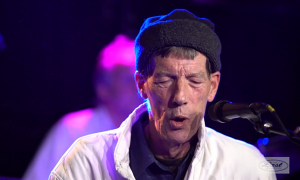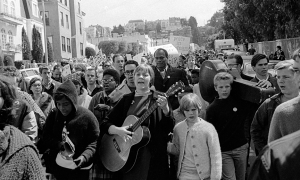Callender may not be a top-of-mind jazz bassist today, but he was hardly a slouch. In addition to appearing on a massive number of recording sessions (441 in total, topped only by Milt Hinton with 1,197 and Ray Brown with 845), Callender accompanied nearly every major jazz musician over seven decades. His phantom status today probably owes something to the fact that he spent a large chunk of his post-1950 career in the West Coast studios and backing other musicians rather than fronting his own groups. [Photo of Red Callender in 1944 with director Gjon Mili, left, and Lester Young on the set of Jammin' the Blues]
When he did record as a leader in the 1950s, the results were superb, particularly when horns were in the mix. From 1955 to 1958, Callender recorded a series of albums under his own name that continue to amaze. The writing is crisp and clever, while the arrangements are crafty and swing beautifully. His choice of musicians for the date also reflects enormous taste.
Callender was born in Virginia and began playing professionally at age 12. He then studied tuba, bass, trumpet and harmony for five years before settling in Los Angeles in 1936 at age 20. A year later, in 1937, he made his recording debut with Louis Armstrong. In 1939 Callender was asked by a young boy named Charles Mingus for bass lessons, and Callender charged him $2 an hour. By the early 1940s Callender was recording steadily with the band Lester Young started with his drummer brother Lee.
An early member of Norman Granz's Jazz at the Philharmonic in 1944, Callender began leading his own trio dates that same year, followed by a sextet session in 1945 that included Harry “Sweets" Edison. Work with Kay Starr in 1945 was followed by recordings with Charlie Ventura in 1946. [Photo of Norman Granz in 1944 by Gjon Mili for Life]
And then it was off to the races for Callender. In the years that followed he recorded with Boyd Raeburn, Nat King Cole, Dinah Washington, Charlie Parker, Wardell Gray, Dexter Gordon, Erroll Garner, Art Tatum, and the list could easily run for at least 100 additional names. As Callender said in the liner notes to one of his mid-1950s albums: “It isn't who I have performed with... but who I haven't." Enormously confident, Callender had a fabulous ear and enormous respect for the listener. As a leader, he instinctively knew what would sound divine without compromising the art of jazz. Most remarkably, his leadership dates from more than 50 years ago still remain fresh and bright today. [Photo of Red Callender's hands in 1944 by Gjon Mili for Life]
A tireless artist, Callender recorded nearly up until his death of thyroid cancer in 1992.
JazzWax tracks: Two excellent CDs capture Callender's stunning output during the 1950s. The first is Red Callender and His Modern Octet: Swingin' Suite (Fresh Sound). It includes the LPs Swingin' Suite (1955) and The Music of Red Callender (1958). These are quartet, sextet and octet sessions featuring Gerald Wilson, Buddy Collette, Billy Bean and other West Coast jazz studio artists of the period. Sixteen of the 19 tracks are Callender originals, and all of the arrangements are his.
The second CD is Red Callender: Speak Low (Fresh Sound), which includes the LPs Callender Speaks Low (1956) and Red Callender (1958). Both are tuba dates, and you're going to be mighty surprised by what you hear. Red Mitchell takes over on bass, and there is supreme flute and reed work by Buddy Collette throughout the CD. A tuba album may sound like a novelty session, but in Callender's hands this is velvety material that seduces as it swings ever so gently. On two tracks, Irving Rosenthal plays French horn, and the merging of that instrument, Collette's flute and Callender's tuba is unbeatable.
You'll find Swingin' Suite here and Speak Low here. Your friends will never pass your Red Callender blindfold test--and you'll leave them begging to know who's playing. Just be sure to tell 'em.
JazzWax tracks: One of the great jazz short films of all time is Jammin' the Blues, which was nominated for an Academy Award in 1944. Not only is it brilliantly lit and directed by Gjon Mili, but it also captures jazz greats of the day in a high-contrast, photographic setting. Mili was a pioneer in the use of the photoflash, and his dramatic lighting sensibilities and still-frame perspective are on display here. Red Callender is the bass player...
This story appears courtesy of JazzWax by Marc Myers.
Copyright © 2025. All rights reserved.



























